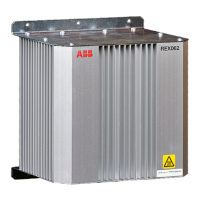It is important that the faulty transformer be disconnected as fast as possible. As the
differential protection is a unit protection it can be designed for fast tripping, thus
providing selective disconnection of the faulty transformer. The differential
protection should never operate on faults outside the protective zone.
A transformer differential protection compares the current flowing into the
transformer with the current leaving the transformer. A correct analysis of fault
conditions by the differential protection must take into consideration changes due to
the voltage, current and phase angle caused by the protected transformer. Traditional
transformer differential protection functions required auxiliary transformers for
correction of the phase shift and ratio. The numerical microprocessor based
differential algorithm as implemented in the IED compensates for both the turn-ratio
and the phase shift internally in the software. No auxiliary current transformers are
necessary.
The differential current should theoretically be zero during normal load or external
faults if the turn-ratio and the phase shift are correctly compensated. However, there
are several different phenomena other than internal faults that will cause unwanted
and false differential currents. The main reasons for unwanted differential currents
may be:
• mismatch due to varying tap changer positions
• different characteristics, loads and operating conditions of the current
transformers
• zero sequence currents that only flow on one side of the power transformer
• normal magnetizing currents
• magnetizing inrush currents
• overexcitation magnetizing currents
7.1.3 Setting guidelines
The parameters for the Transformer differential protection function are set via the
local HMI or Protection and Control IED Manager (PCM600).
7.1.3.1 Restrained and unrestrained differential protection
To make a differential IED as sensitive and stable as possible, restrained differential
protections have been developed and are now adopted as the general practice in the
protection of power transformers. The protection should be provided with a
proportional bias, which makes the protection operate for a certain percentage
differential current related to the current through the transformer. This stabilizes the
protection under through fault conditions while still permitting the system to have
good basic sensitivity. The bias current can be defined in many different ways. One
classical way of defining the bias current has been Ibias = (I1 + I2) / 2, where I1 is the
magnitude of the power transformer primary current, and I2 the magnitude of the
power transformer secondary current. However, it has been found that if the bias
current is defined as the highest power transformer current this will reflect the
difficulties met by the current transformers much better. The differential protection
Section 7 1MRK 502 071-UEN -
Differential protection
128 Generator protection REG670 2.2 IEC and Injection equipment REX060, REX061, REX062
Application manual

